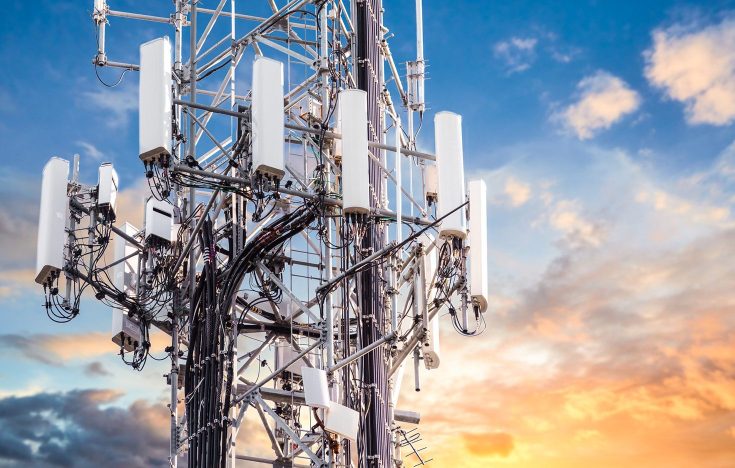Green bond will power General Motors’ electric future
General Motors' inaugural green bond and new Sustainable Finance Framework underline how the US auto industry is revving up EV investments.
Covid-19 acted as a technology catalyst and trends continue to drive investment in 5G infrastructure, media and chips.

From remote surgery conducted by robots to smart factories equipped with self-driving carts and autonomous drones, 5G is beginning to demonstrate its long-hyped potential. The latest global wireless network standard, 5G offers faster speeds, lower latency, reduced energy usage and greater connectivity than previous iterations. It should ultimately enable applications long discussed, such as autonomous driving, 3D video conferencing and Augmented Reality (AR) advertising.
In China and advanced economies, 5G is expanding fast. Gartner predicts 5G coverage across 90% of national populations by the end of 2023 in Greater China, mature APAC, North America and Japan [1]; IDC expects worldwide 5G connections, including Internet of Things (IoT) connections, to grow from 166 million in 2020 to 4.5 billion by 2025 [2]. In the EU, 5G coverage already reaches 64% of the population on average, although some operators achieve this using 4G spectrum.
As the most immediate pandemic pressures ebb, 5G, IoT, Artificial Intelligence (AI), machine learning and big data analytics are entering the steeper part of the adoption curve. Their mutually enhancing capabilities are fuelling longer-term trends that emerged during the pandemic.
The pandemic sharply accelerated a range of digital trends, creating demand for fast, low-latency connections at the consumer level, at the enterprise level and in the space where the two sectors increasingly intersect: working from home.
The many workforce issues Covid-19 presented added further urgency to the trend to factory automation. Relatedly, remote work, virtual collaboration and video conferencing boomed. Beyond making these now-established tools faster and more effective, 5G may bring 3D, AR, Virtual Reality (VR) and Extended Reality (XR) to the home office. Additional 5G use cases from retail to smart homes are becoming more evident as consumers leave home more.
From spectrum to handsets, 5G is reshaping the telecoms universe. Moody’s estimated that operators globally will invest US$600 billion in infrastructure from 2022 through 2025 [3], the overwhelming majority of which will be related to 5G.

Longer term 5G will unlock tremendous growth opportunities across all industries driven by transformative use cases.
Barbara Nash, Managing Director and Head of Technology, Media and Telecommunications Coverage North America, BNP Paribas
Despite ongoing concerns about a recession, “longer term 5G will unlock tremendous growth opportunities across all industries driven by transformative use cases,” said Barbara Nash, Managing Director and Head of Technology, Media and Telecommunications Coverage North America at BNP Paribas. “Infrastructure investment will continue to be a driving force for years to come.”
The Technology, Media and Telecommunications (TMT) team covers corporate segments including fintech, semiconductors, internet, supply chain, digital media, diversified media, software and services, hardware and storage, advertising, analytics and auctions, and telecoms infrastructure.
Lockdowns, venue closures and the desire to avoid crowds meant Covid-19 accelerated the trend to digital video and direct-to-consumer (DTC) media. The precision targeting DTC allows has proved a boon for advertising, yet coexists with and indeed cross-pollinates tentpole opportunities such as the National Football League’s Super Bowl (the most watched TV broadcast in the US annually). In time, 5G will enable features from 3D video to holographic advertising and personalised mobile XR advertising.
In order to increase consumer engagement, media companies are investing in DTC content at unprecedented levels. The consolidation of assets, as seen in the landmark merger of Discovery, Inc. and WarnerMedia, has contributed to the rapid growth of media libraries owned by legacy players. As engagement increases, enhanced connectivity and the faster, richer media 5G delivers will become increasingly important.
While the eureka moment when 5G becomes a consumer essential has yet to occur, the obvious use cases, both present and future, are already driving new partnerships.
“We’re seeing tech and content companies expressing interest in gaming companies: the opportunities relative to gaming and 5G are significant,” Nash said.

The pandemic highlighted weaknesses in supply chains, with semiconductor shortages showcasing the world’s reliance on East Asia. Per Boston Consulting Group, about 75% of semiconductor manufacturing is concentrated in China and East Asia, with 92% of the most advanced semiconductors produced in Taiwan and 8% in South Korea.
Even as pandemic stressors eased, geopolitical tensions in the South China Sea put America’s dependency on Taiwan into focus, making the US CHIPS and Science Act timely. Passed in August, the act commits over US$52 billion to support American semiconductor research, development, manufacturing and workforce development.

We’re seeing incredible investment in semiconductors in the US, not only from US players but also from Taiwanese and Korean players.
Ted Olson, Managing Director, Technology Coverage North America, BNP Paribas
“We’re seeing incredible investment in the US, not only from US players but also from Taiwanese and Korean players,” said Ted Olson, Managing Director, Technology Coverage North America at BNP Paribas. “Multibillion-dollar fabs are under construction in both North America and Europe, and we expect the trend to continue.”
Concurrently, US-based Intel Corp. is in the process of acquiring Tower Semiconductor (a leading analogue chip foundry based out of Israel) for roughly US$5.4 billion, while also investing US$20 billion in the construction of two chip factories in Licking County, Ohio, highlighting recent investments by chipmakers to bolster semiconductor production capacity globally.
While the semiconductor shortage did not significantly slow the rollout of 5G in either the US or Europe, the new generation of 5G smartphones has a much higher chip content than prior generations of phones, providing further tailwinds for semiconductor companies.
Like every new technology development, 5G is not immune from hype. Opportunities such as haptic communication and high-resolution immersive media will not emerge until 6G. Nonetheless, the standard’s evolving capabilities are set to transform the technology, media and telecommunications landscape.
“The pace of change is going to continue to accelerate,” Olson said. “We’re by no means done with regards to 5G-enabled innovation. We’re looking at exciting times as companies across all sectors of the economy continue to invest in technology upgrades.”
[1] Gartner Market Guide for 5G Enterprise Data Services, 29 June 2022
[2] IDC Worldwide 5G Connections Forecast 2021-2025, October 2021
[3] Moody’s “Telecommunications – Global 5G is not yet a game changer”, March 2022
General Motors' inaugural green bond and new Sustainable Finance Framework underline how the US auto industry is revving up EV investments.
Technology company’s first sustainable financings highlight HP’s commitment to ESG and environmental and social ambitions